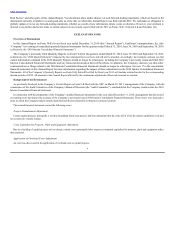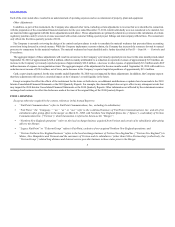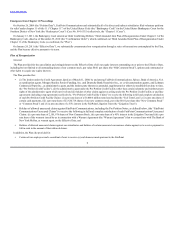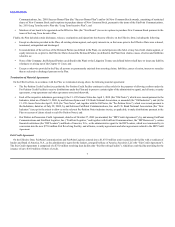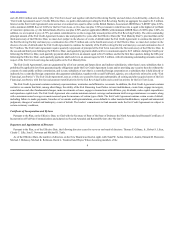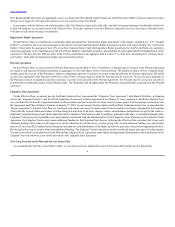FairPoint Communications 2010 Annual Report Download - page 15
Download and view the complete annual report
Please find page 15 of the 2010 FairPoint Communications annual report below. You can navigate through the pages in the report by either clicking on the pages listed below, or by using the keyword search tool below to find specific information within the annual report.
Table of Contents
Local calling service enables the local customer to originate and receive an unlimited number of calls within a defined “exchange” area. Local calling
services include basic local lines, private lines and switched data services. We provide local calling services to residential and business customers, generally
for a fixed monthly charge and service charges for special calling features. In a rural LEC’s territory, the amount that we can charge a customer for local
service is determined by rate proceedings involving the appropriate state regulatory authorities.
We offer switched and dedicated long-distance services within our service areas through resale agreements with national interexchange carriers. In addition,
through our wholly-owned subsidiary FairPoint Carrier Services, Inc., we offer wholesale long-distance services to communications providers that are not
affiliated with us.
Network access enables long-distance companies to utilize our local network to originate or terminate intrastate and interstate communications. Network
access charges relate to long-distance, or toll calls, that typically involve more than one company in the provision of telephone service as well as to the
termination of interexchange private line services. Since toll calls and private line services are generally billed to the customer originating the call or ordering the
private line service, a mechanism is required to compensate each company providing services relating to the service. This mechanism is the access charge and
we bill access charges to long-distance companies and other customers for the use of our facilities to access the customer, as described below.
Intrastate Access Charges. We generate intrastate access revenue when an intrastate long-distance call involving an interexchange carrier is originated by a
customer in one of our exchanges to a customer in another exchange in the same state, or when such a call is terminated to a customer in one of our local
exchanges. We also generate intrastate access revenue when an interexchange carrier orders special access to connect interexchange private line services, such as
HSD services, to a customer in one of our local exchanges. The interexchange carrier pays us an intrastate access payment for either terminating or originating
the communication. We bill access charges relating to such service through our carrier access billing system and receive the access payment from the
interexchange carrier. Access charges for intrastate services are regulated and approved by the state regulatory authority.
Interstate Access Charges. We generate interstate access revenue when an interstate long-distance call is originated by a customer in one of our exchanges
to a customer in another state, or when such a call is terminated to a customer in one of our exchanges. We also generate interstate access revenue when an
interexchange carrier orders special access to connect interexchange private line services, such as HSD services, to a customer in one of our local exchanges.
We bill interstate access charges in the same manner as we bill intrastate access charges; however, interstate access charges are regulated and approved by the
FCC instead of the state regulatory authority.
Universal Service Fund High-Cost Loop. The Universal Service Fund supplements the amount of local service revenue received by us to ensure that
basic local service rates for customers in high-cost areas are consistent with rates charged in lower cost areas. The Universal Service Fund, which is funded
by monthly fees charged to interexchange carriers and LECs, makes payments to us on a monthly basis based upon our cost support for LECs whose cost of
providing the local loop connections to customers is significantly greater than the national average. For our rural service areas, these payments fluctuate based
upon our average cost per loop compared to the national average cost per loop. For example, if the national average cost per loop increases and our operating
costs (and average cost per loop) remain constant or decrease, the payments we receive from the Universal Service Fund would decline. Conversely, if the
national average cost per loop decreases and our operating costs (and average cost per loop) remain constant or increase, the payments we receive from the
Universal Service Fund would increase. For our non-rural service areas, these payments are based on cost models which estimate the cost to provide services
and generate universal service support payments for high-cost areas. Universal Service Fund high-cost support revenue accounted for less than 2% of our total
revenue in the year ended December 31, 2010.
We offer broadband Internet access via DSL technology, fiber-to-the-home technology, dedicated T-1 connections, Internet dial-up, high speed cable modem
and wireless broadband. Customers can utilize this access in combination with customer owned equipment and software to establish a presence on the world
wide web. In addition, we offer enhanced Internet services, which include obtaining IP addresses, basic web site design and hosting, domain name services,
content feeds and web-based e-mail services. Our services include access to 24-hour, 7-day a week customer support.
14


